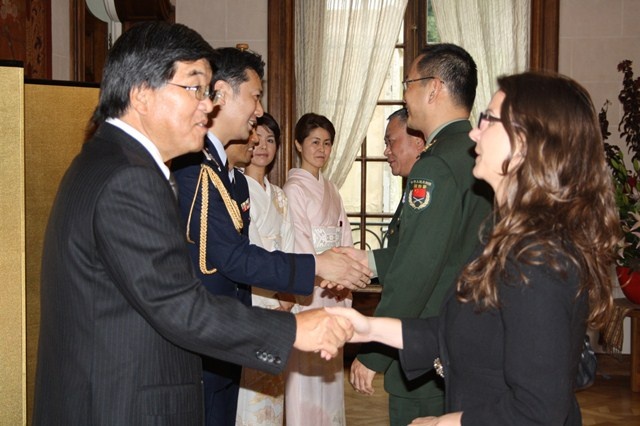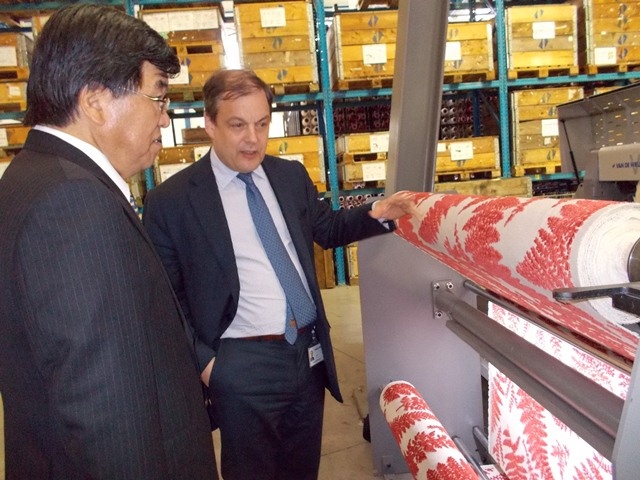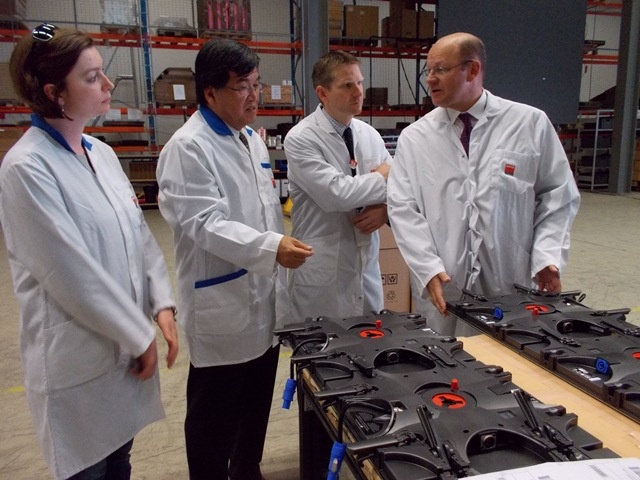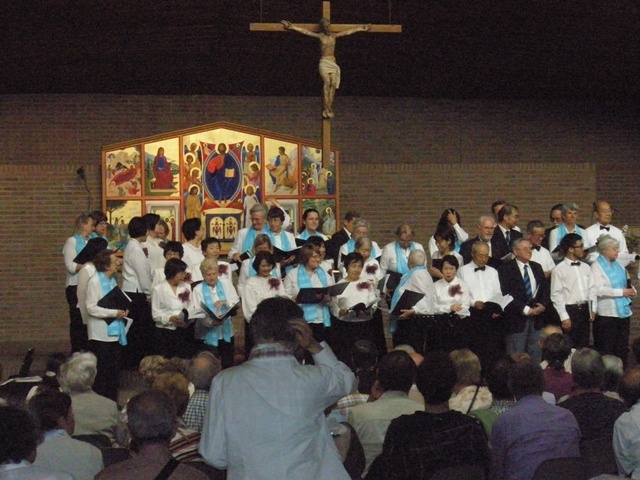Self-Defence Forces Day (No.22)
In Ambassador’s Chat No. 20, I mentioned that a local newspaper stated that the percentage of foreigners in Brussels is 75% (in the broadest sense), but this time, I would like to touch upon another interesting article titled “Non-European Immigrants in Belgium are Decreasing”. According to the annual migration report that was recently published by the Centre for Equality of Opportunities (CEC), there are currently 1.17 million (10.6% of the total Belgian population) foreigners (people of a foreign nationality) living in Belgium. In addition to this, there are 880.000 people who were born in a foreign country, but have obtained the Belgian nationality. If we define this total of 2.05 million people as “foreigner” in a broad sense, a breakdown by country of origin shows that the European countries such as Italy, France and the Netherlands represent 1.06 million people and that non-European countries such as Morocco, Turkey, Congo and others represent 990.000 people. What is interesting is that whereas most of the “foreigners” from European countries keep their nationality, more than 60% of the non-Europeans get the Belgian nationality. However, of the 138.000 people that immigrated to Belgium in 2011, only 35% are non-Europeans, which is a clear downward trend. Compared to the year 2000, it is nearly three times the number of immigrants, but the ratio of immigrants trying to get the Belgian nationality for political reasons (asylum applicants) decreased sharply from 75% to 12% of the total and the number of people that return to their country of origin after having entered Belgium is increasing. Against this background, it seems that the acceptance requirements for asylum seekers by the Belgian authorities are becoming more severe, but I think this ratio is also influenced by the changes in international politics such as the situation in the Middle East, the widening gap between rich and poor and the unemployment problem in the EU. To the Japanese, who are living in isolated islands in the Far East, the “movement of people” that is happening in European countries such as Belgium is beyond imagination.
< Self-Defense Forces Reception held at the Ambassador’s Residence >
 Last Tuesday evening the annual Self-Defense Forces Day Reception was held at the Ambassador’s Residence. Different from the National Day Reception in the winter (see Ambassador’s chat No. 3), the number of guests was limited and weather wise we were able to use the garden, so it did not feel crowded even if held at my residence. In addition to the diplomatic corps (ambassadors, military attachés and so on), the main participants were people from the Belgian government and parliament, officials from the military and the police and people related to NATO. The number of participants was about 160 people, the same as previous years. By the way, the Japanese Self-Defense Forces were established 59 years ago, in July 1954. As the “renunciation of the possession of war potential” is stipulated by article 9 of the Japanese Constitution, the Self Defense Forces are understood as the “minimum required for self-defense capability”. The actual number of Self-Defense Force members is about 225.000 people, ground, sea and air force together. In terms of budget, defense- related expenditures for this year amount to about 36 billion euro which is 7th or 8th in the world. However, in terms of GDP, it is at around 0.9%, which is a very small amount, even compared to the European countries that are hovering around 2%, with the exception of the United States’ 4.3% of GDP. In addition to its main task which is the defense of Japan (to protect the lives and properties of the people), the Self-Defense Forces have secondary missions such as disaster relief and participation in the UN’s peacekeeping operations. According to an opinion poll conducted after the Great East Japan earthquake, more than 90% of the Japanese have a good impression of the Self-Defense Forces and I think that in the unstable situation in East Asia in recent years the interest of the Japanese people in the Self-Defense Forces is increasingly growing. Last Tuesday evening the annual Self-Defense Forces Day Reception was held at the Ambassador’s Residence. Different from the National Day Reception in the winter (see Ambassador’s chat No. 3), the number of guests was limited and weather wise we were able to use the garden, so it did not feel crowded even if held at my residence. In addition to the diplomatic corps (ambassadors, military attachés and so on), the main participants were people from the Belgian government and parliament, officials from the military and the police and people related to NATO. The number of participants was about 160 people, the same as previous years. By the way, the Japanese Self-Defense Forces were established 59 years ago, in July 1954. As the “renunciation of the possession of war potential” is stipulated by article 9 of the Japanese Constitution, the Self Defense Forces are understood as the “minimum required for self-defense capability”. The actual number of Self-Defense Force members is about 225.000 people, ground, sea and air force together. In terms of budget, defense- related expenditures for this year amount to about 36 billion euro which is 7th or 8th in the world. However, in terms of GDP, it is at around 0.9%, which is a very small amount, even compared to the European countries that are hovering around 2%, with the exception of the United States’ 4.3% of GDP. In addition to its main task which is the defense of Japan (to protect the lives and properties of the people), the Self-Defense Forces have secondary missions such as disaster relief and participation in the UN’s peacekeeping operations. According to an opinion poll conducted after the Great East Japan earthquake, more than 90% of the Japanese have a good impression of the Self-Defense Forces and I think that in the unstable situation in East Asia in recent years the interest of the Japanese people in the Self-Defense Forces is increasingly growing.
< Two Belgian Companies in Kortrijk >
 Last week I visited Kortrijk (90km west of Brussels; 74.900 inhabitants) and paid a visit to two large Belgian companies in that area. First I met again with Mr. Charles Beauduin, CEO of Van de Wiele, after our first meeting two months ago (see Ambassador’s Chat No. 16). Van de Wiele started its activities in 1880, currently employs 2500 people and manufactures various types of weaving machines. Annual sales amount to about 450 million euros and in the field of carpet weaving machines Van de Wiele boasts the number one share in the world (about 70%). The relationship with the textile industry in Japan is also deep. Apart from the 30-year collaboration with Toray and Teijin, they are also selling weaving machines to towel manufacturing companies in Imabari city, Japan. Moreover, most of these machines are made by the Japanese Yamazaki Mazak Corporation. While guiding me through the factory, CEO Beauduin also told me about his two-year stay in Japan as a government-sponsored foreign student at the Keio University with a scholarship from the Japanese Ministry of Education. Last week I visited Kortrijk (90km west of Brussels; 74.900 inhabitants) and paid a visit to two large Belgian companies in that area. First I met again with Mr. Charles Beauduin, CEO of Van de Wiele, after our first meeting two months ago (see Ambassador’s Chat No. 16). Van de Wiele started its activities in 1880, currently employs 2500 people and manufactures various types of weaving machines. Annual sales amount to about 450 million euros and in the field of carpet weaving machines Van de Wiele boasts the number one share in the world (about 70%). The relationship with the textile industry in Japan is also deep. Apart from the 30-year collaboration with Toray and Teijin, they are also selling weaving machines to towel manufacturing companies in Imabari city, Japan. Moreover, most of these machines are made by the Japanese Yamazaki Mazak Corporation. While guiding me through the factory, CEO Beauduin also told me about his two-year stay in Japan as a government-sponsored foreign student at the Keio University with a scholarship from the Japanese Ministry of Education.
 My next visit was to BARCO, a world leader in the field of imaging solutions. I was welcomed by President Eric Van Zele and Senior Vice-President Jacques Bertrand, who worked for nearly 10 years in Japan. BARCO is manufacturing mainly ultra-large displays such as those used in airport control towers, police traffic control centers or at outdoor events, but they are also expanding their market share in the field of medical imaging equipment such as displays for digital mammography. LED technology is introduced by NICHIA Corporation and there’s also a deal with UCHIDA YOKO for educational equipment and with the optical equipment manufacturer ELMO Company. Very interesting was the explanation about the audio equipment for large projectors and 3D sound used in movie theaters, for example. In this field the BARCO’s global market share reaches nearly 50%. The company’s digital audio equipment has already been introduced in 40.000 movie theaters all over the world and the latest 3D audio system called Barco Sound has been introduced in 200 movie theaters. BARCO started as a furniture manufacturing company in 1934 and then they also entered the market of electrical appliances from the time they started to produce wooden boxes for the American Radio Corporation and began to manufacture TV’s as well. Not being able to compete internationally, BARCO seems to have found a way out via the field of the latest digital display devices like they do today. Last year’s sales figures were 1.15 billion euro; there are 1800 employees in the factory in Kuurne near Kortrijk only, BARCO has a large factory in China and there seems to be a sales center in Heiwajima in Tokyo too. It is admirable that this company has become so successful in the niche world. My next visit was to BARCO, a world leader in the field of imaging solutions. I was welcomed by President Eric Van Zele and Senior Vice-President Jacques Bertrand, who worked for nearly 10 years in Japan. BARCO is manufacturing mainly ultra-large displays such as those used in airport control towers, police traffic control centers or at outdoor events, but they are also expanding their market share in the field of medical imaging equipment such as displays for digital mammography. LED technology is introduced by NICHIA Corporation and there’s also a deal with UCHIDA YOKO for educational equipment and with the optical equipment manufacturer ELMO Company. Very interesting was the explanation about the audio equipment for large projectors and 3D sound used in movie theaters, for example. In this field the BARCO’s global market share reaches nearly 50%. The company’s digital audio equipment has already been introduced in 40.000 movie theaters all over the world and the latest 3D audio system called Barco Sound has been introduced in 200 movie theaters. BARCO started as a furniture manufacturing company in 1934 and then they also entered the market of electrical appliances from the time they started to produce wooden boxes for the American Radio Corporation and began to manufacture TV’s as well. Not being able to compete internationally, BARCO seems to have found a way out via the field of the latest digital display devices like they do today. Last year’s sales figures were 1.15 billion euro; there are 1800 employees in the factory in Kuurne near Kortrijk only, BARCO has a large factory in China and there seems to be a sales center in Heiwajima in Tokyo too. It is admirable that this company has become so successful in the niche world.
< Japanese Students at a European Research Institute >
Nearby the Ambassador’s Residence in Ixelles there’s a building named Institute for European Studies (IEE) and just when I thought that I would like to pay a visit, I learned from its Deputy Director Mr. Mario Telo, whom I met during a talk with members of the Free University of Brussels (ULB), that this facility was founded in 1963 as an educational institution affiliated to the ULB. I was thus invited immediately by Mr. Telo and the other day I visited this institute. There are about 300 students at present: 250 master courses and 50 doctoral programs. The nationalities of the students are mixed. Around 20% of the total is Belgian and there are also three Japanese students. On the day of my visit, I spoke with about ten doctoral students, among which two male students from Waseda University. The problem of this institute seems to be the “doubt that the educational content is not good because the tuition is too low” (a doubt from foreign students that do not know this institute). By the way, in case of an EU research scholarship for the doctoral program, the student receives every month an amount of 2800€, which is equivalent to a monthly salary of a mid-level office worker. Every year more than 200 people from all over the world apply for this scholarship, but only 10 are admitted. Only the truly outstanding students are selected, which also suggests the high level of education and research at the IEE. The relation between IEE and Japan goes back about 20 years when besides the cooperation with Waseda University, also cooperative relations with Hitotsubashi University, Sophia University, the International Christian University and other universities were established. Such relations should be developed further.
< ISB and Kesennuma High School >
16 high school students (and 3 accompanying teachers) from the International School of Brussels (ISB) are currently visiting Kesennuma City in Miyagi Prefecture as part of the “Building International Bridges” project. The group will stay one week in Kesennuma. After being reunited with the students from the Kesennuma High School, the group will go to Tokyo, Nagoya, Hiroshima and Kyoto where joint visits are planned to historic sites together with Japanese high school students. On the last day of their nearly 3-week stay in Japan, the ISB students will join the Kesennuma High School students again in Kyoto, where a farewell party will be organized. I would like to participate as well to such a splendid program, but the reason for organizing this program is linked to the Great East Japan Earthquake & Tsunami victim support. Belgian volunteers started one year ago the “Building International Bridges” project and invited 32 high school students from 5 schools in Miyagi Prefecture to Belgium. The other day, I met with Ms. Lauren Nijkerk-Bogen (a Dutch woman whose two children attend ISB), one of the initiators of this project, at the Embassy and we discussed the details of her project. I was impressed by her enthusiasm to unify victim support and international exchange. In addition, the organization of such activities requires a lot of money and the cooperation of many people, so I admire her wonderful organizational strength. When volunteer projects as well reach this level, it really makes you feel a great power.
< A Joint Japanese-Belgian Choir in Saint-Marc’s Church >
 Beginning of last month, on Sunday, I went to the Saint-Marc’s Church in Uccle to attend as a guest a joint choir concert by a Japanese and Belgian amateur choir group. The Belgian choir is a group of enthusiasts from Uccle and the Japanese choir is a group called “Otozure” from Tokyo. The choirs with mixed voices performed each mainly Japanese songs and it was a harmonious concert. The Saint-Marc’s Church is a parish church with a modern architecture. You cannot tell it is a church at first glance. Also in Belgium, which is said to be a country of devout Catholics, the faith of young people faded during the last 20-30 years and the number of believers going to church every Sunday has decreased dramatically. For this reason, the Church is struggling to find a solution for the maintenance costs of the church buildings. It is said that many churches rent their space as a venue for concerts and exhibitions and depend on this income from rental fees. A Belgian told me, smiling wryly, that “some churches turn into discotheques in the weekend”. An image of Jesus crucified on the cross was suspended right above the stage of the joint choirs’ concert, so it felt somewhat strange to listen to Japanese songs in such a place. However, for the Jesus in question, it might have been a good thing to listen to beautiful singing voices over two and a half hours and look down on fraternizing choir enthusiasts. Beginning of last month, on Sunday, I went to the Saint-Marc’s Church in Uccle to attend as a guest a joint choir concert by a Japanese and Belgian amateur choir group. The Belgian choir is a group of enthusiasts from Uccle and the Japanese choir is a group called “Otozure” from Tokyo. The choirs with mixed voices performed each mainly Japanese songs and it was a harmonious concert. The Saint-Marc’s Church is a parish church with a modern architecture. You cannot tell it is a church at first glance. Also in Belgium, which is said to be a country of devout Catholics, the faith of young people faded during the last 20-30 years and the number of believers going to church every Sunday has decreased dramatically. For this reason, the Church is struggling to find a solution for the maintenance costs of the church buildings. It is said that many churches rent their space as a venue for concerts and exhibitions and depend on this income from rental fees. A Belgian told me, smiling wryly, that “some churches turn into discotheques in the weekend”. An image of Jesus crucified on the cross was suspended right above the stage of the joint choirs’ concert, so it felt somewhat strange to listen to Japanese songs in such a place. However, for the Jesus in question, it might have been a good thing to listen to beautiful singing voices over two and a half hours and look down on fraternizing choir enthusiasts.
|